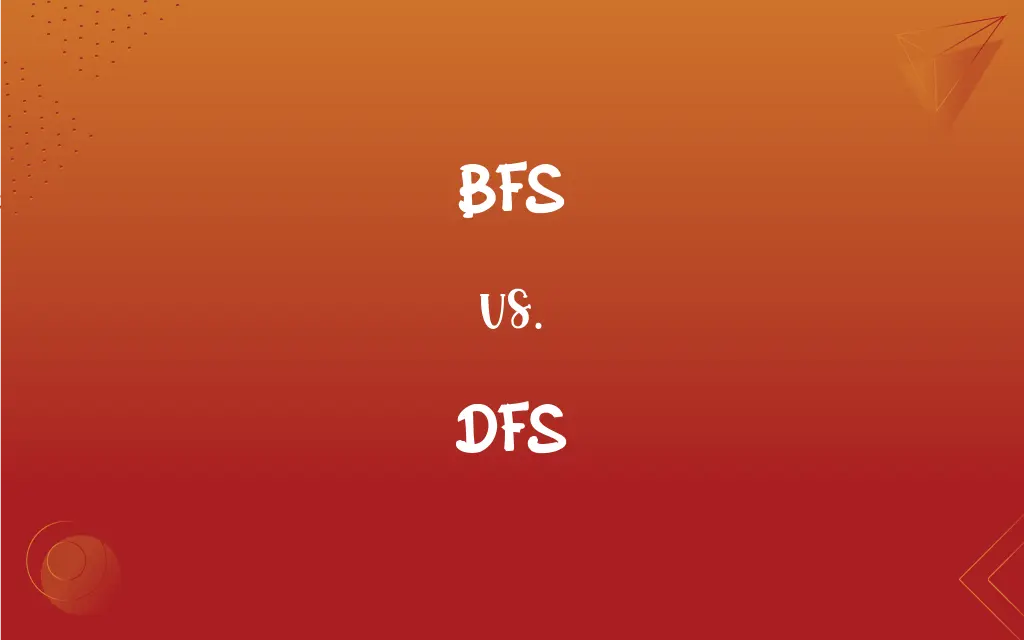BFS vs. DFS: What's the Difference?
Edited by Aimie Carlson || By Janet White || Published on February 14, 2024
BFS (Breadth-First Search) explores neighbors of a node before visiting their children; DFS (Depth-First Search) explores as far as possible along a branch before backtracking.

Key Differences
BFS systematically explores a graph level by level, starting from the root node and moving outward, ensuring all nodes at the current depth are visited before moving to the next level. DFS, conversely, dives deep into one path of the graph as far as possible until it hits a leaf or a dead end, then backtracks and explores other paths.
BFS uses a queue data structure to keep track of the nodes to visit next, maintaining a record of all immediate child nodes before moving deeper. DFS uses a stack data structure, either as an explicit stack or through recursion, exploring each branch to its fullest before retreating.
In BFS, the memory requirement can be more significant, especially if the tree or graph is wide, as it keeps track of all nodes at a particular depth. DFS, in contrast, is more memory-efficient in narrow, deep trees as it only needs to store a single path from the root to a leaf node.
BFS is particularly useful in shortest path algorithms and scenarios where the solution is not far from the root of the tree. DFS is suited for tasks like puzzle games, where exploring each option to its end is necessary, or in scenarios where the solution space is deep and solutions are rare.
BFS guarantees to find the shortest path in an unweighted graph, making it suitable for such problems. DFS, while not always finding the shortest path, can be faster in searching over vast spaces where the target is likely deep within the graph.
ADVERTISEMENT
Comparison Chart
Exploration Strategy
Level by level, exploring neighbors first.
Deep exploration of one branch before backtracking.
Data Structure Used
Queue.
Stack or recursion.
Memory Usage
Higher in wide graphs.
Lower in deep graphs.
Suitability
Shortest path and solutions near root.
Solutions deep in the graph and exhaustive searches.
Path Finding
Always finds the shortest path in unweighted graphs.
May not find the shortest path but can be faster in some cases.
ADVERTISEMENT
BFS and DFS Definitions
BFS
It requires more memory in wide graphs.
In our wide tree structure, BFS consumed considerable memory.
DFS
It's suitable for exhaustive searches and puzzles.
DFS effectively solved the complex maze by exploring every possible path.
BFS
BFS explores a graph level by level.
Using BFS, we found the shortest path in an unweighted graph.
DFS
DFS is more memory-efficient in deep graphs.
In our deep hierarchical data, DFS's memory usage was minimal.
BFS
BFS is suitable for finding the shortest path in unweighted graphs.
BFS was ideal for quickly locating the nearest exit in a maze.
DFS
DFS may not always find the shortest path.
Using DFS, the algorithm found a solution, though not the shortest one.
BFS
It uses a queue to keep track of nodes to visit.
The algorithm queued each neighbor node for systematic exploration.
DFS
It uses a stack or recursion for backtracking.
The DFS algorithm recursively explored each path in the graph.
BFS
BFS is efficient for exploring networks with solutions near the root.
BFS efficiently handled our network analysis for local connections.
DFS
DFS explores as far as possible along a branch before backtracking.
DFS was used to deeply search the decision tree for the optimal solution.
BFS
Plural of bf
FAQs
How does BFS work?
It explores all neighbor nodes at a given depth before moving to the next level.
What is the strategy of DFS?
It dives deep into one path until it hits a dead end, then backtracks.
When should you use DFS over BFS?
In exhaustive searches or when solutions are deep within the graph.
What is BFS?
Breadth-First Search, an algorithm for exploring graphs level by level.
What does DFS stand for?
Depth-First Search, an algorithm for exploring graphs as deep as possible along each branch.
Can BFS find the shortest path?
Yes, in unweighted graphs.
What are common use cases for DFS?
Puzzle solving, topological sorting, and exploring decision trees.
What data structure does BFS use?
A queue.
When is BFS more suitable than DFS?
In scenarios like finding the shortest path in unweighted graphs.
What data structure is used in DFS?
A stack or recursion.
Does DFS always find the shortest path?
No, it may not find the shortest path.
Is DFS suitable for searching large areas quickly?
Yes, if the target is likely to be deep within the search space.
Is BFS memory-intensive?
Yes, especially in wide graphs.
What type of problems is BFS commonly used for?
Problems like shortest path finding and level order traversal in trees.
What role does recursion play in DFS?
It helps in exploring each branch to its deepest point.
Can BFS be used for tree traversal?
Yes, especially for level-order traversal.
How does the queue in BFS function?
It keeps track of the nodes to be explored next.
What's a limitation of BFS?
Its high memory usage in wide graphs.
What's a drawback of DFS?
It may not be efficient for finding the shortest path.
Is DFS memory-efficient?
Yes, particularly in deep graphs.
About Author
Written by
Janet WhiteJanet White has been an esteemed writer and blogger for Difference Wiki. Holding a Master's degree in Science and Medical Journalism from the prestigious Boston University, she has consistently demonstrated her expertise and passion for her field. When she's not immersed in her work, Janet relishes her time exercising, delving into a good book, and cherishing moments with friends and family.
Edited by
Aimie CarlsonAimie Carlson, holding a master's degree in English literature, is a fervent English language enthusiast. She lends her writing talents to Difference Wiki, a prominent website that specializes in comparisons, offering readers insightful analyses that both captivate and inform.







































































